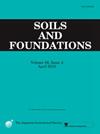利用纳米化学稳定技术加固路基粘土
IF 3.3
2区 工程技术
Q2 ENGINEERING, GEOLOGICAL
引用次数: 0
摘要
目前,非传统的环保纳米材料添加剂在软土的岩土稳定中得到了广泛的应用。利用纳米技术开发的材料在稳定土壤中的应用,有效地减少或取代了水泥和石灰等胶结产品的使用,从而导致环境污染。本文评价了有机硅烷纳米化学添加剂添加1%水泥粘结剂对改善道路用软土强度性能的效果。研究人员进行了一系列实验测试,以表征含有1%水泥粘合剂的软粘土和纳米化学处理软土的岩土力学特性,包括土壤级配、稠度极限、压实、无侧限压缩和加州承载比(CBR)强度,以及微观结构和化学分析。在母质粘土中加入少量1%的水泥,以加速纳米化学添加剂处理过的土壤的胶凝反应。在本研究中,纳米化学添加剂的用量为0.03% ~ 0.05%。对处理后的粘土进行了试验,以确定固化至28天的土样的最高无侧限抗压强度所对应的最佳用量。试验结果表明,有机硅基纳米化学剂在掺量为0.045%、水泥粘结剂掺量为1%的条件下处理软粘土获得了最大的无侧限抗压强度和CBR强度。SEM和FTIR结果假设微观结构和化学相互作用参与支持改善处理土壤强度的机制。本文章由计算机程序翻译,如有差异,请以英文原文为准。
Strengthening the subgrade clay soil using nano chemical stabilisation
Nowadays, non-traditional eco-friendly nanomaterial additives are widely utilized in the geotechnical stabilization of soft soils. The application of materials developed using nanotechnology in stabilizing soils effectively reduces or replaces the utility of cementation products like cement and lime, which leads to environmental pollution. This article evaluates the efficacy of organosilane nano-chemical additive with 1 % cement binder in improving the strength properties of soft soil used for road-based applications. A series of experimental tests were conducted to characterize the geotechnical properties of soft clay and nano-chemical-treated soft soils with 1 % cement binder, including soil gradation, consistency limits, compaction, unconfined compression, and California bearing ratio (CBR) strength, and microstructural and chemical analysis. A small dosage of 1 % cement was added to the parent clay to accelerate the cementitious reactions in soil treated with a nano-chemical additive. The dosage of nano-chemical additives used was varied from 0.03 to 0.05 % for the present study. The treated clayey soil is examined for the optimum dosage corresponding to the highest unconfined compression strength of soil samples cured up to 28 days. Test results show that the soft clay treated with organosilane-based nano-chemical at an optimum dosage of 0.045 % and 1 % cement binder has attained the maximum unconfined compression and CBR strengths. SEM and FTIR results postulate the microstructural and chemical interactions involved in supporting the mechanism of improvement in the strength of treated soils.
求助全文
通过发布文献求助,成功后即可免费获取论文全文。
去求助
来源期刊

Soils and Foundations
工程技术-地球科学综合
CiteScore
6.40
自引率
8.10%
发文量
99
审稿时长
5 months
期刊介绍:
Soils and Foundations is one of the leading journals in the field of soil mechanics and geotechnical engineering. It is the official journal of the Japanese Geotechnical Society (JGS)., The journal publishes a variety of original research paper, technical reports, technical notes, as well as the state-of-the-art reports upon invitation by the Editor, in the fields of soil and rock mechanics, geotechnical engineering, and environmental geotechnics. Since the publication of Volume 1, No.1 issue in June 1960, Soils and Foundations will celebrate the 60th anniversary in the year of 2020.
Soils and Foundations welcomes theoretical as well as practical work associated with the aforementioned field(s). Case studies that describe the original and interdisciplinary work applicable to geotechnical engineering are particularly encouraged. Discussions to each of the published articles are also welcomed in order to provide an avenue in which opinions of peers may be fed back or exchanged. In providing latest expertise on a specific topic, one issue out of six per year on average was allocated to include selected papers from the International Symposia which were held in Japan as well as overseas.
 求助内容:
求助内容: 应助结果提醒方式:
应助结果提醒方式:


